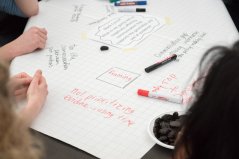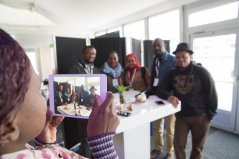
Nieuws
Seven insights into communicating evidence for sustainable development
Communication plays an important role in transformation processes and in the generation and use of evidence for sustainable development. It thus should be integrated from the planning phase onwards to support learning, sense-making and decision-making. This was one of the findings of the ‘Communicating Evidence for Sustainable Development’ conference of the Wageningen Centre for Development Innovation.
In April the conference ‘Communicating Evidence for Sustainable Development’ took place in Wageningen, as part of the annual WCDI series ‘Monitoring and Evaluation on the Cutting Edge’. The conference featured keynotes by prof. dr. Noelle Aarts (Radboud University) and dr. Irene de Goede (Oxfam Novib).

Clarity in the role of communication
The conference aimed to seek clarity in the role communication can play in generating and using evidence for sustainable development. Some key insights have now been summarized in a report, together with an overview of the keynotes, workshops and discussions.
The key insights are, in short:
1. Understand that evidence is contested and realise that evidence does not speak for itself. What some groups consider to be true, may not resonate with other groups at all, depending on their framing of the issue at hand. To be effective, communication of evidence needs to be “credible, well-timed, carefully framed and communicated, propositional (solution-oriented) and supported by other strategies”, according to dr. Irene de Goede of Oxfam Novib in her keynote.
2. Engage with the users of evidence to better understand their needs, wishes and context, so as to define what evidence needs to be generated and shared. In other words, we need to generate useful evidence, that fits the context of those we would like to influence.
3. Value different perspectives and engage in dialogue. The five guidelines for dialogue are: listen with attention and respect; recognise different truths; make underlying norms, assumptions and fears explicit; take emotions seriously; and be aware of identity and relational dynamics. “To stay critical we need to listen to people that think differently”, prof. dr. Noelle Aarts stated in her keynote.
4. The importance of bridging (connecting with people who think differently) calls for people to work together in interdisciplinary or transdisciplinary teams. This will help to tackle complex issues that need to be addressed by different disciplines and people that can bridge between different disciplines and perspectives.
5. Mix methods and build up a powerful narrative. Using a mix of quantitative and qualitative M&E/research methods, as well as a mix of communication methods can help to build a story to tell to convince people to change.
6. Stimulate shared learning and sense-making as this is crucial for informed decision-making. It calls for a safe space to dialogue and a culture of learning, leadership support and commitment to change.
7. Integrate communication from the planning phase. Qualitative, learning-oriented methods can play a role in integrating communication in research or monitoring and evaluation from the start, and encouraging learning and sense-making. The conference featured five ways to do so.

More detailed information on each topic, including background papers, presentations, videos and photos, can be found at our Managing for Impact website and in the digital report.